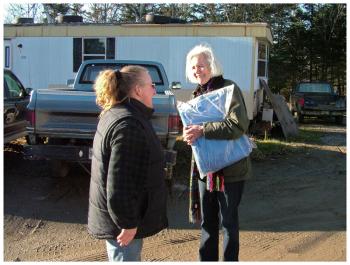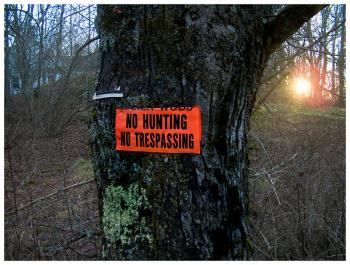Early returns from Islesboro's late season hunt
ISLESBORO - Outside Laura and Cliff Houle's auto garage, junkyard and oil delivery service, five deer lay in the back of a refrigerated truck. They were all does. And all of them had been killed with guns, which, depending upon who you ask, is a new thing on Islesboro.
Laura had removed one tooth from each, measured antlers of those that had them and logged numerous other details about the circumstances of their death. The teeth will be sent to a lab in Montana for tests that will ultimately be reviewed by several Maine state agencies and epidemiologists. Other communities around the state are also reportedly waiting on the results.
For all the CSI-like meticulousness, these deer were killed legally — the first in a special deer hunt that islanders hope will curb the incidence of Lyme disease, which has been on the rise in recent years with occasional, dramatic spikes in infection rates.
Islesboro had 27 confirmed cases of Lyme disease in 2011. The number was a marked jump from the steadily increasing single-digit counts of the past decade — a trend briefly broken in 2008 when there were 18 cases — and there were many more "possible" cases.
"After last year we kind of sounded the alarm," said Gordon Murphy, a physician assistant at the Islesboro Health Center. "We did lectures at the Sportsman's Club, churches, schools."
As a result more people sought treatment after any kind of contact with ticks. Some of these visits were unnecessary, but in other cases the Health Center was able to administer prophylactic antibiotics — single dose treatments given when the circumstances favor infection but symptoms have yet to appear.
Not all deer ticks carry Lyme disease, but series of studies by Maine Medical Center's Vector-borne Disease Laboratory spanning over a decade found an increasing percentage of deer ticks in Islesboro do — 49 percent as of the last study in 2010.
"So people here have about a 50-50 chance, if a tick is on them long enough, of contracting Lyme disease," said Alison Wood, one of three physician assistants along with Murphy at the Islesboro Health Center.
Deer ticks need a large host to survive. On Islesboro that's meant deer, dogs or humans, and by accounts both scientific and anecdotal, Islesboro has more than enough deer to keep the disease on the upswing.
Murphy said the Health Center has tried to stay out of the debate over the strategy of thinning the deer population to stop the spread of Lyme disease, but like many people interviewed for this article, he expressed a casual confidence that the island indeed has a lot of deer.
"All you have to do is drive around at dusk," he said.
In 2010 a consulting firm estimated the density of deer on the island based on counts of droppings at 62 per square mile, or 744 total deer on the island. That year, selectmen formed the Tick-Borne Disease Prevention Committee to make recommendations about combating Lyme disease. After an expanded archery season, a second count found the population reduced to around 48 per square mile.
The "tick committee" as it became known, made an extensive study of other communities with high rates of Lyme disease, including island communities in New York, Massachusetts and Maine, and documented what they did about it. Some did nothing, but the majority that had any success chose to aggressively reduce — or in the case of Monhegan Island, totally eliminate — the deer population, usually with guns.
Among the four recommendations the Islesboro tick committee made in its 60-page final report to selectmen in May 2011 was a call to adopt a Wildlife Management plan, including a special deer hunting season using firearms in addition to the expanded archery season. The goal would be to reduce the deer population to the common benchmark density of 10 per square mile.
"There was always a belief that if you contained the deer population you could reduce Lyme disease," said Laura Houle, who served as chairwoman of the tick committee.
A year-and-a-half later, she was one of two people on the island responsible for tagging deer during the first of what could be several years worth of special deer hunts.
"We would love to see 100 deer," she said. "That's the ultimate goal, to see 100 deer during the special hunt. We'll see if that happens. Almost 50 people qualified, so if each person got one deer, we'd be halfway there."
By midday on the fourth day of the hunt, Dec. 13, there were twelve fewer deer on the island. Five of those had been shot on the first day. Speaking on Dec. 11 — a day when not a single deer would come in — Houle said had her own questions about how successful the hunt would be.
Among hunters she'd talked to, some thought the deer would be harder to find in December as they went deeper into the woods and settled in for winter. Others, she sad, suspected a larger shift in the deer population. To back it up, they offered anecdotal accounts of sitting in the woods for two or three days without seeing a deer when once there had been herds.
"There are people who say the deer aren't here, that you don't have the number of deer you had five years ago or 10 years ago," she said. "But then there are people who see deer all over the place, so it depends who you talk to."
Doug and Normajean Welldon, residents of the north end of the island, aren't hunters and by their own account, they've had no problem finding deer. Five does regularly visit their back yard, they said, where they've taken to eating flower plantings, including varieties deer supposedly don't like.
The Welldons were in favor of the special deer hunt and have allowed several neighbors to hunt on their property, but not just because they see the deer as pests. Normajean said she was infected with Lyme disease after walking in the tall grass at the edge of her yard and said since then her joints haven't been the same. Doug said the deer are pervasive enough that a cursory scan of the woods at night with a flashlight is likely to catch some glowing eyes.
"We'd like to see them ... never again," he said.
PenBayPilot.com did not meet any opponents of the hunt on a recent visit to the island, but others interviewed estimated the dissenters at between 15- and 25-percent of property owners. A 2011 vote that authorized the special deer hunt, passed by a margin of 100-28, and a subsequent vote earlier this year that approved the final plan passed by a voice vote.
Linda Gillies, who served on both the tick and deer reduction committees cited three main reasons residents didn't want the special hunt: general opposition to killing animals, concern from hunters who felt the added hunt would disrupt established patterns, and safety concerns related to the introduction of guns.
"There have always been guns, but you just don't talk about it," Gillies said.
Having retired to Islesboro in 2007, Gillies didn't claim first-hand knowledge, but said people who grew up on the island have described illegal hunting with guns as being common at various times in the past. "This would be organized," she said.
The big-picture effect of the hunt may take years to determine. On Dec. 11, however, Gillies and Houle were focused on the little things: another tarp for the truck, a way to make sure the deer carcasses didn't freeze if the outdoor temperature dropped, and the question of how long to wait before bringing them to the mainland where the town has arranged to pay for processing.
"Who's going to take this batch of deer?" Gillies said. "It was very hard to make that decision until we had the deer in hand, which now we do."
The special deer hunt started on Dec. 10 and runs through Dec. 31. The authorization granted by the Maine Department of Inland Fisheries and Wildlife for the hunt allows for additional firearms hunts in 2013 and 2014 in order to reach the 10-per-square-mile goal.
For the roughly 50 islanders licensed for the hunt, the goal is more straightforward: go get a deer, or two.
"It's the best we could figure out, and whether it will work we don't know," Gillies said. "But it's our best shot."
For more information on this article, contact news@penbaypilot.com





































